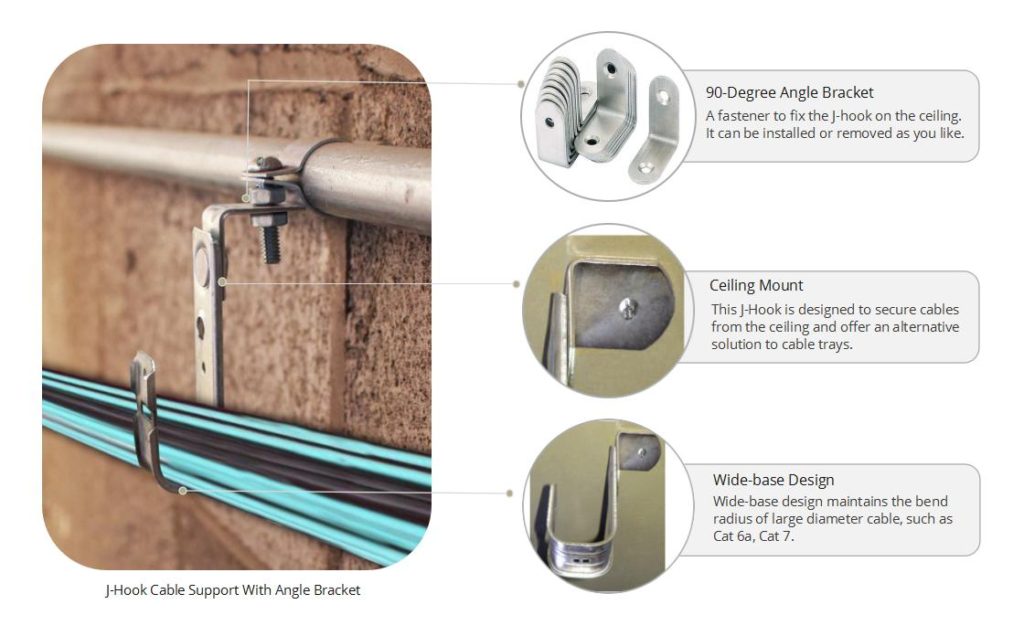Background Introduction
When holding and pulling the Cat 5e patch cords to deploy high density network, you should do some special handling for them, so that they can be more supported than the less-sensitive voice-grade cables used in traditional cable pulls. Why it is required? It’s because if you just use the narrow-base fasteners like cable ties and bridle rings to hang and support the cable bundles, the stress points will be created and the bend radius of Cat 5e patch cords will be exceeded. Under this condition, the Cat 5e patch cords are easy to be damaged by any overbending, twisting or stressing that may cause your network failure.
But how to make the Cat 5e cabling for ensuring the performance of the high density network? In fact, there are two solutions put forward to deal with the issue, the horizontal cabling tray and the J-Hook. Considering that the horizontal cabling tray solution is more expensive and time-consuming to install than the J-Hook one, so it is not recommendable at all. As for the J-Hook solution, it is much more practical, specially designed for high density network cabling. Let’s study the main features and advantages of the J-Hook solution and learn how to use the wide-base J-Hook for supporting the Cat 5e patch cords for better network cabling.
J-Hook Overview
J-Hook is a special kind of fastener, usually made of galvanized steel but sometimes of plastic polymers, which can be installed in both indoor and outdoor high density application for supporting more than one Ethernet patch cable or cable bundle. It is easy to learn that its structure is like the letter “J” from its name, while from the following figure it is better to know its “J” structure that features a wide base with smooth and rounded corners and 90-degree angle bracket. This design is able to eliminate the potential for snags during installation, while preventing the development of stress points where the cable bundle is supported. As for its application, J-Hook can be easily and fast installed in various environments, such as beams, "C" or "Z" purlin, acoustical trees, drop wires, decks, and ceilings. In short, J-Hook offers an alternative solution to the cabling tray which is very cost effective to secure the cables like Cat 5e, Cat 6 and Cat 6a patch cords in the whole network.

How to Use the Wide-base J-Hook for Supporting the Cat 5e Patch Cords?
As mentioned above, the wide-base J-Hook is specially designed to support the Ethernet patch cables. But how to use it to achieve the aim? Is it difficult to be installed? Let’s take the step by step procedures about using the wide-base J-Hook for supporting the Cat 5e patch cords in the following text as an example.
- Firstly, attach the proper J-Hook--whether for wall, stud, beam, flange or drop-wire mounting--to the supporting structure. Space the J-Hooks to fall every 4 to 5 feet.
- Secondly, put the Cat 5e patch cords in the J-Hooks. Ensure that the cable sag between the J-Hooks is less than 12 inches at midspan. If the sag is more than 12 inches, then you should add additional J-Hooks to support the cables. (Cable sag in actual application will rely on the number of cables in each bundle and the weight of the cables.)
- Thirdly, if the J-Hook is able to work with the cable tie, you are suggest to use the prepunched holes in the J-Hook to install the tie. This prevents the Cat 5e patch cords from lifting. Be sure that the cable tie does not put pressure on the cables which may cause the geometry distortion of the cables.
- Finally, check the whole installation and confirm there is no problem in the installation. Meanwhile, please ensure that the overall appearance of installed cable is neat.
Note: During the installation process, you should keep the cable-pulling tension constant and keep it below the EIA/TIA-568A specification for the Cat 5e patch cords.
Conclusion
J-Hook is a good solution to deploy and manage the Ethernet patch cables like Cat 5e patch cords in the high density network, which enables neat and high performance network, and money and time savings. In contrast with other cable management tools, it requires fewer materials and can be easier and faster to be installed. Hence, if choosing the J-Hook solution to manage the cables in high density environment, you can save a lot of time and money.
No comments:
Post a Comment